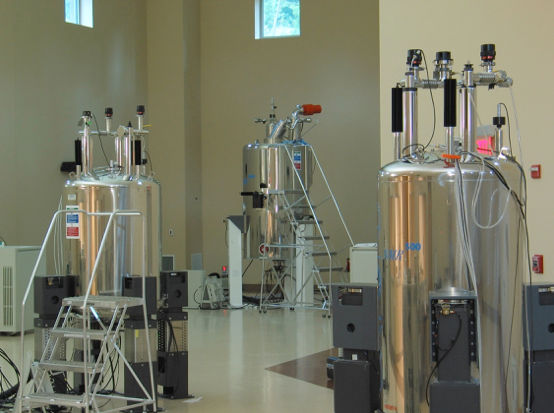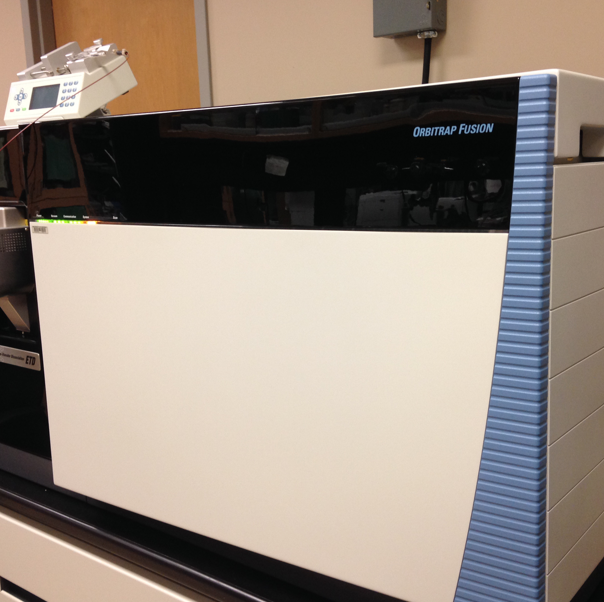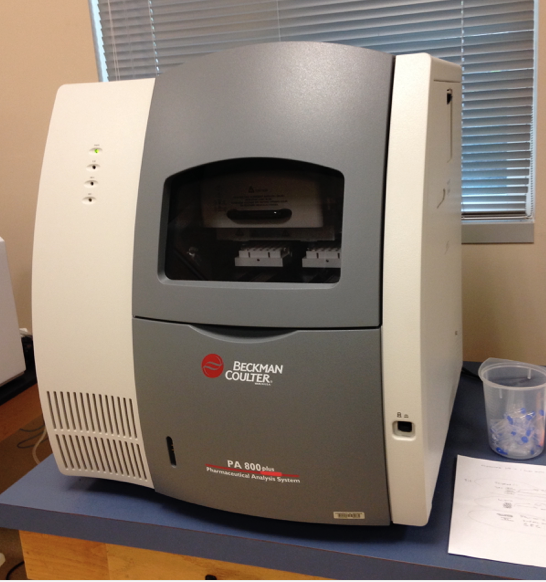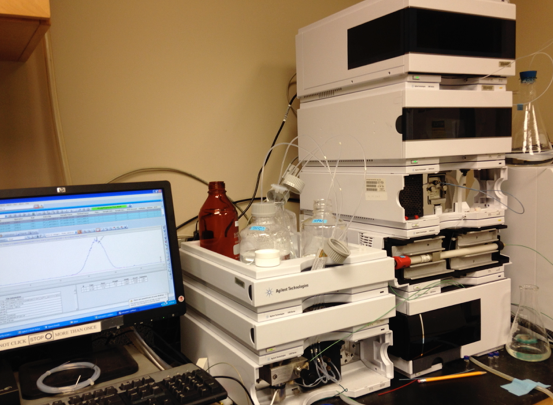Techniques
Please contact Dr. Azadi at Azadi@uga.edu for more information
1D abd 2 DNMR
1D and 2D NMR
One-dimensional NMR
- 1D NMR defines the types of anomeric configuration (a,b) present, provides information about non-carbohydrate substituents (e.g. acetyl or pyruvyl moieties) and quantify degree of substitution.
- 1D NMR provides information about the purity of the carbohydrate.
- For polysaccharides with a repeating sequence, both 13C-NMR and 1H-NMR give information regarding the number of monosaccharide residues contained in the repeating glycosyl.
- 13C-NMR can provide some information regarding glycosyl linkage and can detect the presence of unusual or rarely observed sugars. We can also acquire 31P-NMR spectra.
Two-dimensional NMR
- If a sufficient amount of pure polysaccharide (>5 mmol) is available, 2-D NMR spectroscopy is probably the single most powerful technique for the elucidation of the precise carbohydrate structure.
- A routine set of experiments for structural determination of a polysaccharide would include COSY, TOCSY, HSQC, HMBC and NOESY or ROESY.
- Additional experiments include HSQC-TOCSY to correlate carbon resonances within a given monosaccharide residue, DOSY for the determination of molecular weight and of intermolecular bonding, band-selective homonuclear decoupled experiments for crowded spectra, and 1H-31P-HMQC and HMQC-TOCSY to establish the attachment sites of phosphomono-and diesters, as well as spin-diffusion experiments to determine the binding sites of small ligands to large receptors.
- The CCRC has the following NMR instruments available for use:
- 300 MHz (2 channel, gradients)
- 500 MHz (, 3 channel, gradients), can be used in conjunction with dynamic hyperpolarization
- 600 MHz (3 channel, gradients, cryoprobe)
- 800 MHz (3 channel, gradients, cryoprobe)
- 900 MHz (3 channel, gradients, cryoprobe)

Caption
ESI-MS/MALDI-MS
MALDI-and ESI-MS are used for the elucidation of glycoconjugate structures from various biological samples. In general, a smaller amount of sample is needed by these techniques compared with other analytical techniques.
- For single purified glycoprotein, a sample amount that would provide a minimum of 500 pmol of analytes would produce a clear result. A relatively higher amount is needed for crude glycoprotein origins like tissues. For cells, a count of not less than of 107 is adequate to acquire a reliable data.
- Our laboratory has the expertise to process glycoproteins from a gel or gel pieces.
- Preferably, the sample should be pure, soluble in water or 50% ethanol in water and free of non-volatile salts, buffers, and detergents. However, our laboratory has the capability to process samples with potential contaminants.
Matrix-Assisted Laser Desorption Ionization Mass Spectrometry (MALDI-MS)
MALDI-MS is a fast and excellent technique for the determination of molecular weight (up to about 150 kDa) of oligosaccharides, peptides, glycopeptides, glycoproteins and other glycoconjugates.
- A sample could be analyzed in its native or derivatized form (e.g. permethylated oligosaccharides).
- Depending on the kind of glycoconjugate, a matrix is selected for crystallization (e.g. DHBA, CHCA), and an appropriate method based on expected molecular weights is chosen for acquiring data.
- Identification of signals is accomplished through the use of free access databases.
- MALDI MS provides a good profile of parent molecular ions present in the sample.
- The CCRC Analytical Services Laboratory has two (2) MALDI units; Applied Biosystems AB SCIEX TOF/TOF 5800 with high resolution, and Bruker microflex.

Caption
Electrospray/Nanospray Ionization Ion-trap Mass Spectrometry (ESI/NSI-MS and MS/MS )
ESI-MS is an excellent tandem with MALDI-MS analysis. Through MS/MS, ESI/NSI mass spectrometry is a confirmative technique for the elucidation of oligosaccharides, peptides and glycopeptides.
- A sample could be analyzed in its native or derivatized form (e.g. permethylated oligosaccharides).
- A method is being used to capture all possible ions present in the sample.
- Structures previously identified through MALDI-MS are confirmed, modified or deleted based on the fragmentation pattern observed.
- The CCRC Analytical Services Laboratory has four (4) ESI/NSI-MS units; Thermo Orbitrap Fusion, Thermo Velos Pro Orbitrap Elite, Thermo LTQ XL Orbitrap Discovery, and Thermo Finnigan LTQ MS.
On-Line Liquid Chromatography-Electrospray Ionization-Mass Spectrometry (LC-ESI-MS)
LC-ESI-MS is an application for acquiring full MS and tandem MS/MS data to achieve detailed structural characterization of biological sample mixture or pharmaceutical drug product mixture. While separating the analytes by LC, MS analysis of each eluate is simultaneously archived on line.
- LC-ESI-MS is used mainly for the full characterization of a target protein’s N-and O-linked glycosylation, mapping of glycosylation sites and extent of glycosylation at each site.
- LC-ESI-MS is also used for the profiling of low molecular weight heparin and other pharmaceutical products.
- The CCRC Analytical Services Laboratory has an Ultimate 3000 nano LC interfaced to a Thermo Orbitrap Fusion, which is suitable for samples that are oftentimes very limited in quantity such as those for proteomics/glycoproteomics experiments.
- A Thermo Ultimate 3000 analytical LC coupled to a Velos Pro Orbitrap Elite is also available for applications that require high reproducibility and rapid profiling such as pharmaceutical drugs.
- Our LC-MS systems have Electron Electron Transfer Dissociation (ETD) and High Collision Dissociation (HCD) fragmentation capabilities, which allow in-depth structural characterization of analytes.
- Softwares are being used as tools for data analysis; Thermo Proteome Discoverer™ and Protein Metric’s Byonic ™.

Caption
GC-MS
Gas Chromatography-Mass Spectroscopy (GC-MS)
GC-MS is used for the quantification and accurate identification of monosaccharides originating from plant and microbial polysaccharides and glycoconjugates. The technique is also used for determining linkage positions in residues composing oligosaccharides or polysaccharides.
- For monosaccharide composition analysis, the sample is hydrolyzed with an acid to form methyl glycosides, which are subsequently derivatized for GC analysis by electron impact setting (EI).
- Uncommon or unidentified residues detected by EI setting are further evaluated through chemical ionization (CI) setting to obtain molecular weights, which are matched with the EI information to deduce possible glycosyl identification.
- Glycosyl linkage analysis is accomplished by subjecting the sample to permethylation procedure, hydrolysis, and acetylation of hydroxyls to form partially methylated alditol acetates (PMAAs).
- PMAAs are analyzed by GC-MS and a free access database is available at CCRC.
- The CCRC Analytical Services Laboratory has five (5) units of Agilent GC-MS with EI, one (1) Shimadzu GC-MS with CI setting and one (1) GC-FID.

GC-MSD6 For Alditol Acetate and Linkage
CE/CE-MS
Capillary Electrophoresis (CE) is a family of separations techniques that resolves analytes based on their charge-to-size ratio. Capillary electrophoresis and Capillary Gel Electrophoresis are frequently used methodologies in carbohydrate separations for their superior separation efficiencies and quick analysis times.
- Additionally CE is a high-throughput, low sample consumption methodology that is well suited for quality assurance, characterization, and fingerprinting studies.
- With the application of fluorescent labeled to a glycan or oligosaccharide’s reducing end, CE-based separations can be used for quantification, as well as for very low limits of detection.
- The CCRC Analytical Services Laboratory has a Beckman Coulter PA800 Pharmaceutical Analysis System that may be coupled with UV, PDA, or Fluorescence Detection modules. Also, our laboratory has a Beckman Coulter CESI 8000, the first commercially available system designed to couple CE separations to mass spectrometry.

Caption
HPAEC
High Performance Anion Exchange Chromatography-Pulsed Amperometric Detection (HPAEC-PAD) is a sensitive, fast, accurate and precise method for quantification of monosaccharides/sialic acids from glycoproteins.
- HPAEC-PAD is also excellent for quantification of phosphorylated monosaccharides (e.g. mannose-1-phosphate, mannose-6-phosphate, glucose-1-phosphate, glucose-6-phosphate), disaccharides and trisaccharides and for separation, profiling and isolation of oligosaccharides.
- HPAEC can be interfaced with a UV detector for quantification of nucleotide sugars or with a conductivity detector for determination of inorganic salts such as sulfate, phosphate, fluoride, chloride, nitrate and nitrite.
The CCRC Analytical Services Laboratory has two (2) units of DIONEX ICS 3000 chromatography system, which can be fitted with various columns depending on specific analysis.

High Performance Anion Exchange Chromatography-Pulsed Amperometric Detection (HPAEC-PAD)
HPLC
High Performance Liquid Chromatography (HPLC) is a fast, robust analytical technique with a wide array of application in the laboratory.
- HPLC is frequently used for size exclusion chromatography (SEC) of polysaccharides and glycosaminoglycans (GAGs) to determine molecular weight, separation and isolation of carbohydrates by size and detected by RI and/or ELSD.
- With CTA-SAX column, HPLC is used to determine the distribution of low molecular weight heparin (LMWH) as an indicator of extent and pattern of depolymerization of heparin.
- HPLC is also used for analysis of disaccharides from GAGs with a UV detector followed in sequence by post column derivatization with a fluorescent detector.
- With appropriate column, we use HPLC to analyze, separate, isolate and/or purify peptides and glycopeptides including preparation for downstream analysis like mass spectrometry.

High Performance Liquid Chromatography (HPLC)
